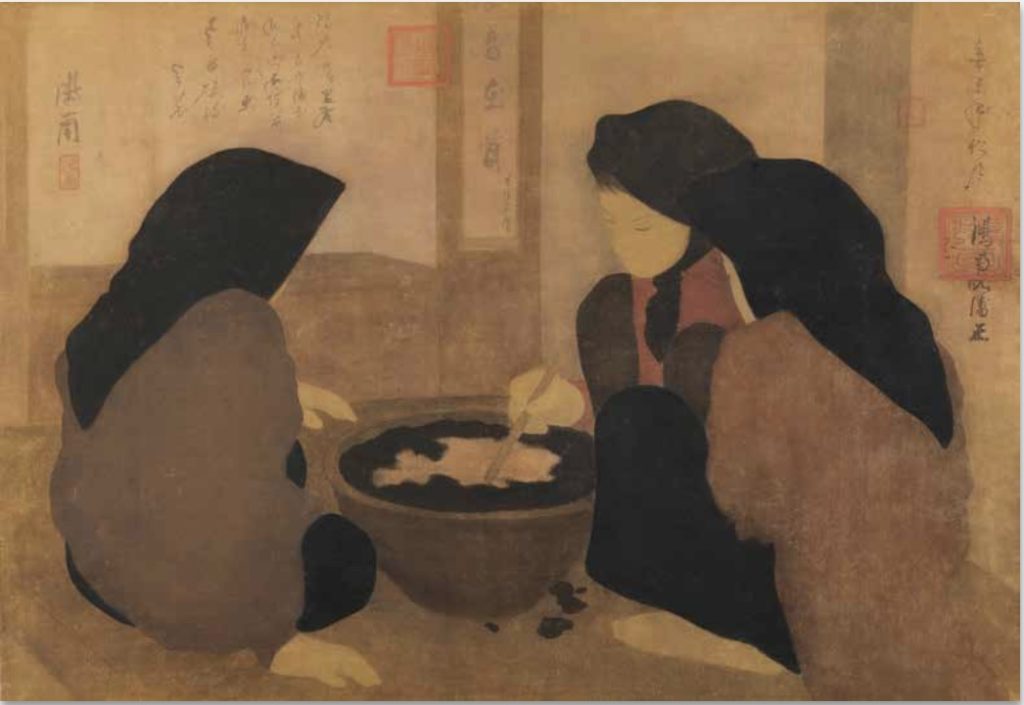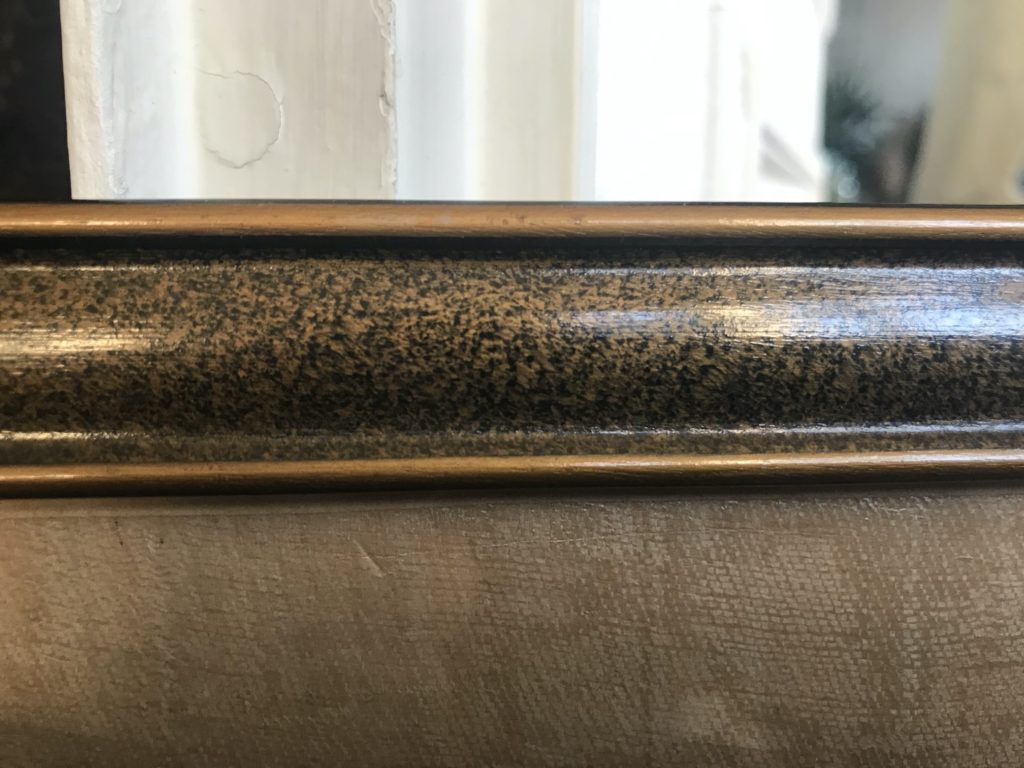Nguyen Phan Chan « Les Teinturières », 1931: The Meaning Of Sign
Nguyen Phan Chanh probably painted Les Teinturières in November 1931, just as the Paris Colonial Exhibition was coming to an end. This exhibition, which took place from 6 May to 15 November 1931, brought to him true recognition in the art world of Paris, the “City of Lights”, directly or indirectly sought after by all artists of the century. Nguyen Phan Chanh never went to the Paris Exhibition, but Victor Tardieu and Le Pho assured him of his success and that of the Hanoi School of Fine Arts, which was now propelled beyond the very respectable, yet nonetheless limited in sphere circle in Hanoi.

The painter was fully aware of this change of scale when he painted this picture in the winter (which starts in November in Hanoi) of 1931. It therefore follows in the footsteps of Les Couturières (from the Jean-Marc Lefèvre collection sold last year at Christie’s), one of the six silks sent to the Colonial Exhibition. Les Teinturières, based on a similar format, theme and technique was sent to France a little later as seen by its original Gadin frame.

To truly appreciate the work, it is important to understand the painter’s life.
This painter is unique among the Hanoi School of Fine Arts’ first class of graduates, starting from his background – which provides so many clues to understand his work. He was an older graduate (38 years old) compared, for example, to his fellow students Le Pho and Mai Thu who graduated at 23 and 24 years old respectively, and is not from Hanoi but of much more humbler origins. Hailing from his native village Trung Tiet in the province of Ha Thinh, life was a difficult one. However this tougher upbringing also lent a different sensitivity to his art.
Educated by a literate and Confucian father, he was an orphan by the age of 7 and helped his mother by selling his drawings in the markets or by drawing portraits from photographs. At the age of 9, he started learning Chinese characters which he would later teach before joining the Franco-Vietnamese education system. In 1922, he joined the pedagogical school of Hué, graduated in 1923, and became a teacher at the Dong Ba elementary school of the city. In 1925, he was the only candidate from Annam to be admitted in the Hanoi School of Fine Arts’ first entrance examination.
Victor Tardieu, an enthusiast of history and tradition, understood immediately the importance of Asian silk painting and decided to integrate its practice to his classical teachings of oil on canvas from the French. Nguyen Phan Chanh magnificently expressed his passion for a sublimated simplicity. He delivered his first gouache and ink on silk in 1929. His mastery of clair obscure (chiaroscuro) is thus established.
The masterpiece Les Teinturières reproduces the same general characteristics, classical theme and technique emblematic of the painter’s unique style but additionally here, an exceptionally interesting calligraphy is on display.
The classical theme refers to humble figures in the midst of traditional activities, with their faces either covered quasi-anonymous, in a seemingly huis-clos, despite being outside. Here, clothes are dyed in preparation for the new year (Têt) soon to come. This old world still remains traditional despite the rapid urbanization of the region. This work displays more black than usual: on scarves and pants, but also black dye stains outside and inside the cauldron. The simple clothes, almost androgynous in style, contrast with the beautiful Hanoian women adorned with their ao dai and their jewelry, or their affluent interiors found in the times of Le Pho or Mai Thu. The painter’s austerity is illustrated by the three barefoot figures working on a task in a simple interior.
The technique: the triangles of black masses worn by the three figures (the headdresses – one of which even ends angular, the lower limbs, the interior of the cauldron, the traces of the overflowing dye), the vertical lines (used to create the wall of the house), the columns, the hues of brown, the tonal subtlety of the gouache and the drastic purity of the ink combines in a mysterious harmony.
Classically, in most of his works, the painter offers a simple calligraphy placed beside the subject and expressing his name as a painter, his complete name and the date. Here, there is an abundance of ideograms that constitute the work itself because, for the painter, these ‘little people’ (the common folk), must receive the distinction of what the artist presumes as a superior art form: Chinese calligraphy. Inscriptions and seals come to structure the work as in Kandinsky.
But with Nguyen Phan Chanh here, the form has a meaning, and aesthetics is also rhetorical.

2. Stamp: “Hong Nan“
3. Poem:
“The heated charcoal in winter eases my illness.
It seems spring is about to return for the plum blossom outside the window.
And thousands of butterflies will return for our reunion.
It is time to prepare new clothes for the coming of Spring.”
4. Stamp: “Hong Nan“
5. Inscribed: “The four seasons start with Spring”
6. Inscribed: “executed by Nguyen Phan Chanh”
7. Stamp: “Hong Nan”
8. Inscribed: year “Xin-Wei” and “winter”
9. Stamp: “Hong Nan”
10. Inscribed: “Hong Nan”, “Nguyen Phan Chanh“
From left to right of the calligraphy, there are four Hong Nan stamps and two Hong Nan inscriptions, and twice the inscription Nguyen Phan Chanh. One should also note the different sizes of the stamps, which calibrate the aesthetics aspect.
A very beautiful poem, in the center, explains the work by sublimating it:
« The heated charcoal in winter eases my illness.
It seems spring is about to return for the plum blossom outside the window.
And thousands of butterflies will return for our reunion.
It is time to prepare new clothes for the coming of Spring. »
Poems are very rare in the painter’s work, and only three including this one have been noted so far if we refer to contemporary works: La marchande de ôc, 1929, and Les Couturières, 1930. This is akin to a solemn triptych of works, similar in subject and commonality.
In the centre of the calligraphy, like a banner, “the four seasons start with Spring” is identified.
And, below, in small characters : “Painted by Nguyen Phan Chanh”.
On the right side, a small stamp “Hong Nan”.
On the right, from bottom to top, the year “xin-wei” (1931) and “Winter” are indicated, with Winter beginning in November in Hanoi.
Referring to mother tongue, the French literary theorist Roland Barthes wrote: “The writer is someone who plays with his mother’s body.” The painter, referring to the writings of the ancients, pays homage to his father and the scholarship imparted. Above all, the work is exceptional because the artist uses calligraphy as a building block for the very composition of his work.
Nguyen Phan Chanh refused to witness this world become outdated, for him nothing can be equivalent or can replace it.
For him, there would be no quest for the West as there was for Le Pho, Mai Thu, Vu Cao Dam, Le Thi Luu and others, not even a desire for the future.
In this late 1931, painting his Vietnam was his only quest.
Jean-François Hubert